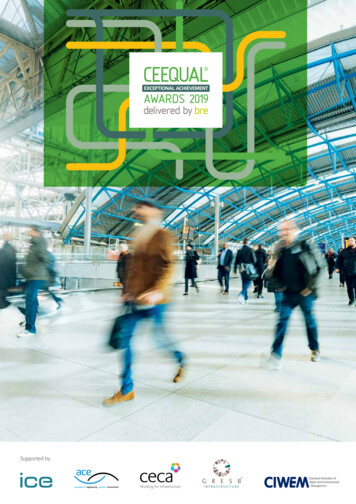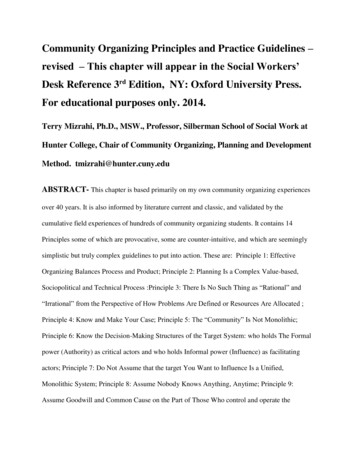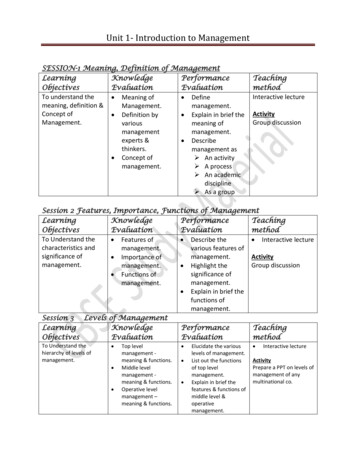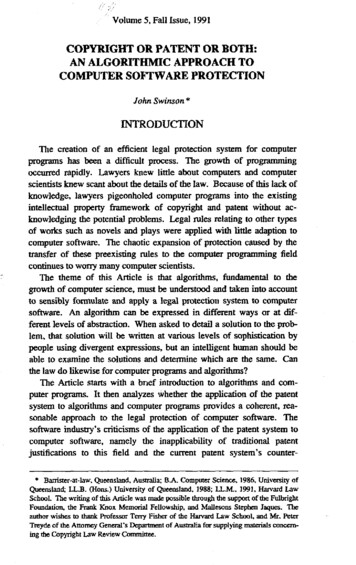
Transcription
Supported by
23ForewordIan NicholsonTerry FullerIntroductionDIRECTOR OF CEEQUALAND INFRASTRUCTURECHAIR OFJUDGING PANELOur congratulations to all the inspiring projects that were nominatedfor the 2019 Awards. The independent judging panel had the difficultbut rewarding task of examining the excellent short-listed projects andselecting the best. Exceptional Achievement Awards will be presentedin the following categories: had the difficult but rewarding task ofexamining the excellent short-listed projects and selecting the best.Exceptional Achievement Awards will be presented in the followingcategories:It is a great pleasure, and honour, to introducethe 2019 Exceptional Achievement Awardsand continue the tradition of celebratingthe exemplary outcomes of sustainability incivil engineering. The keen eyed will noticethe change of name from Outstanding toExceptional, this is to avoid confusion with thenew Outstanding rating for projects introducedin CEEQUAL Version 6.Version 6, launched in June 2019 achieved the long-stated objectiveof bringing together the best of both BREEAM Infrastructure andCEEQUAL methodologies. I am proud to say that CEEQUAL is nowtruly embedded in the BREEAM family and will continue to developalongside the other schemes to enable sustainability assessment of allaspects of the built environment.As always it has been a privilege to get out and about meeting manyCEEQUAL users and present CEEQUAL certificates to inspiring projects.This year has been a particularly special year in that regard as it alsosaw the presentation of the first CEEQUAL certificate in Qatar, and theMiddle East. I am also delighted to see the Doha South Sewerage teamextend their recognition with an Exceptional Achievement Award.I would like to extend my thanks to everyone involved with CEEQUAL,both internally within BRE, our working groups and users across theworld for your enthusiasm, dedication and hard work; all of you makeCEEQUAL what it is!The construction industry has a significantresponsibility to become more sustainable inits operations and in what we build. We haveopportunity to be leaders in tackling the climateand ecological emergency that our planet facesand to inspire by showcasing excellence. This iswhy CEEQUAL is so important and why it hasbeen a privilege for me to chair the panel ofjudges for the Exceptional Achievement Awards.The projects that we have assessed this year are of various scopeand demonstrate how projects with both large and small budgetscan exemplify sustainable practices. The best examples are whereopportunities are secured that provide benefit beyond the core remitand objectives as well as being intrinsically sustainable. It is particularlyexciting when we come across a practice or idea that is scalable andcan be adopted by the construction industry and other sectors.- Strategy & Management- Effects on Neighbours- Community & Stakeholder RelationsAbout CEEQUALCEEQUAL is an evidence-based sustainability assessment, ratingand certification scheme for civil engineering, infrastructure,landscaping and public realm projects. It promotes and celebrates highenvironmental and social performance in the specification, design, andconstruction of civil engineering works.By providing a rigorous and comprehensive sustainability assessmentand rating, CEEQUAL helps clients designers and contractors toimprove their projects. CEEQUAL has been successfully used onhundreds of projects in countries around the world.- Restoration of Contaminated LandCEEQUAL certification is available for clients, designer s andcontractors to publicly demonstrate the sustainability of their projects.Pinnacle best-practice is celebrated at the Exceptional AchievementAwards.- Ecology & Biodiversityhttps://www.ceequal.com/- Landscape- Historic Environment- Water Environment & ResourcesCEEQUAL Exceptional Achievement Awards- Energy & CarbonThe CEEQUAL Exceptional Achievement Awards recognise andacknowledge projects that demonstrate pinnacle best-practiceperformance in any area of the CEEQUAL assessment. Irrespective ofthe total score of the CEEQUAL Award achieved. They highlight someof the top sustainability achievements by civil engineering projectsteams around the world.- Material & Waste Management- Director’s Corporate Award- Director’s Individual AwardThe judges also gave special recognition to one of the nominatedprojects by presenting The Eric Hughes Award for OutstandingContribution to Improving Sustainability.
45About the judgesMany thanks to our independent Panel of Judges whohave undertaken the difficult task of selecting the Awardwinning and Highly Commended projects from theexcellent and wide ranging nominations.Leading figures in the fields of civil engineering andsustainability, they have brought their considerableexperience and expertise to the judging process.We would like to express our gratitude to ICE, ACE, CECA, GRESB and CIWEM for theirsupport of the 2019 Exceptional Achievement Awards.Andy SwainJudith SykesNatalie CroppAndy is a chartered environmentalist andsustainability professional. He started hiscareer in the construction industry with BAMNuttall before moving into the quarrying andbuilding materials sector with AggregateIndustries and more recently Tarmac. AtTarmac, he is responsible for the deliveryof the corporate sustainability strategy andnon-financial reporting. Andy is a passionateadvocate of CEEQUAL having been involvedin the early development of the scheme.He is a CEEQUAL Senior Verifier and waschair of the technical advisory group anda member the CEEQUAL Board prior toacquisition by BRE.Judith has over 20 years’ experience in masterplanning, sustainable design and strategy.Her background is in major infrastructureprojects and masterplans, having worked onHeathrow Terminal 5 and the London 2012Olympic Park. She has particular expertisein infrastructure planning to support urbanregeneration. She has technical expertisespanning carbon, water, waste, greeninfrastructure, the circular economy, healthand wellbeing and social value. She is partof the winning VeloCity team for the Oxfordto Cambridge Ideas Competition run by theNational Infrastructure Commission and hasrecently been appointed Design Advisor tothe NIC.Natalie is Sustainability Director for TonyGee and Partners and is Chair of the ACESustainability Group. Natalie is an experiencedcivil engineer having worked on a range ofUK infrastructure projects.Peter CroslandRick WaltersTerry FullerPeter is a Chartered Civil Engineer and aChartered Water & Environmental Managerwith over 35 years’ experience of working onprojects in the UK and Internationally. He hasadvised on multi-disciplinary projects includingeducation, infrastructure, buildings (commercialand housing), sewerage, water treatmentand water supply and the investigation andremediation of brownfield sites.Rick is Director, Infrastructure at GRESB andis an experienced sustainability professionalwith a diverse background covering morethan 25 years’ experience in sustainability,investment, engineering and management.Before joining GRESB, Walters was a founderof the Infrastructure Sustainability Council ofAustralia where he led the development ofits sustainability rating scheme, the first of itskind in Australia.Terry is Chief Executive of CIWEM responsiblefor delivering the Institution’s strategic aimsand its services to members and the publicinterest. He has over 30 years’ experience asa water and environmental manager havingdelivered major projects in some of the world’smost beautiful and challenging locations.Previously, Terry managed the rivers and coastalbusiness for Jacobs Engineering working intheir global business development group.Terry is a member of CIWEM, serving on thecommittee of their Rivers and Coastal Groupbetween 2004 and 2011. He has also servedas a Board Trustee, and was chair during its60th anniversary year in 2009.Peter has worked for numerous major publicand private sector organisations during hiscareer and has acted at Divisional, Regionaland Strategic Director level. Peter is now theNational Civil Engineering Director for theCivil Engineering Contractors Associationand advises on health, safety, environmental,water, technical, contractual and commercialissues. He is currently Chair of the HSETackling Ill-Health Working Group, Vice Chairof the ICE H&S Expert Panel and member ofthe HCLG Exec Committee.Mission-driven and investor-led, GRESB isthe environmental, social and governance(ESG) benchmark for real assets. We workin collaboration with the industry to providestandardized and validated ESG data to thecapital markets.She holds the position of SustainabilityManager for the Midland Metro Alliance,developing tram links across the WestMidlands.Terry has always been active in helpingto influence policy and research and hasrepresented both CIWEM and the ICE at severalinternational conferences. Terry firmly believesthat water should be managed by consideringthe entire water cycle and all demands placedon water.
67Strategy &ManagementEffect onNeighboursWinnerWinnerColwyn Bay Waterfront Project Phase 2London Bridge Station Redevelopment(Main Station)Client: Conwy County Borough CouncilDesigner: Mott MacDonald, BCA LandscapeClient: Network RailContractor: Volker Stevin Ltd., Elate ConstructionDesigner: Hyder Consulting (now Arcadis), WSPCEEQUAL Excellent (76.5%)Whole Team, Version 5, June 2018Contractor: CostainThe Colwyn Bay Waterfront Project is a prime example of bestpractice in the delivery of a highly sustainable civil engineeringscheme that has delivered many additional benefits. The projectachieved a CEEQUAL Excellent Whole Team Award and has also wonseveral industry awards, including those from the ICE and CIHT.As Phase 2 was a continuation of the wider Colwyn Bay WaterfrontProject, skills and resources remained within the project teamthroughout, so there was strong appreciation of the benefits theCEEQUAL process could bring. The client fully embraced this process,while the project team decided early on to use it as a guidingdocument to ensure they grasped all opportunities for best practice.From the outset, the project team used a tool developed by MottMacDonald called ‘Design for Resource Efficiency’ (D4RE), whichfocused on aspects such as energy reduction, water reduction andsustainable procurement. By adopting this approach, the projectachieved around a 300,000 saving on disposal costs, a 48% averagesaving on paving, street furniture, kerbs and paved areas by usingover-ordered materials on other council schemes and a 30% reductionin carbon emissions.Judges praised the overall principles and approach of the client anddesigners, commenting the strategy was ‘very good’.A great project witha clear link betweenthe process and theoutcomes delivered.CEEQUAL Excellent (97.3%)Whole Project, Version 4, May 2019The 7 billion Thameslink Programme meant redeveloping andreconfiguring London Bridge station, with significant changesto the eastern and western approaches. As well as delivering aworld-class transport interchange, the project created a brandnew, street-level concourse that provided new entrances onto neighbouring Tooley Street and St. Thomas Street. Given itslocation, noise was a significant constraint to the constructionprogramming and phasing.Major programmes such as the Thameslink Programme inevitablygenerate noise and vibration, but as part of its vision to deliver asustainable programme, the project team committed to implementingrobust controls to keep these impacts to a minimum.In particular, it appointed a night shift Noise and Nuisance Advisorwho helped reduce the impact of night works and was instrumentalin gaining trust, leading to approval for extended working hoursovernight and at weekends. As a result, the project was awarded theNoise Abatement Society ‘John Connell Silent Approach’ Award.Network Rail, Costain and the supply chain collaboratively ensuredthe project created a lasting legacy for the station and surroundingareas and delivered it in a way that sets a blueprint for major complexprojects. Acknowledging this, the judges said the team demonstrated‘a real commitment to ensuring that the project minimised disruptionThey havedone a fantasticjob at minimisingdisruption.to neighbours and the public’.
89Community &Stakeholder RelationsWinnersHighly CommendedAinsdale StationTyeA4232 Cardiff Eastern Bay LinkClient: Merseyrail Electrics 2002 LtdClient: Hammarö communityDesigner: Owen Ellis ArchitectsDesigner: Skanska Sweden AB, SWECO, RamböllContractor: Morgan SindallContractor: Skanska Sweden ABCEEQUAL Excellent (75.9%)Whole Team, Version 5, December 2018CEEQUAL Excellent (87.9%)Whole Team, Version 5, February 2018Client: Welsh GovernmentDesigner: Capita, Cass HaywardContractor: Dawnus Ferrovial Agroman JointVentureCEEQUAL Excellent (81.1%)Whole Team, Version 5, March 2018During design development, the projectteam adopted a range of technical measuresin response to stakeholder feedback and tomitigate nuisance from the new road. Andthroughout the construction phase, the teamheld focus groups to gather feedback andkept the local community up to date with theproject through its external communicationsplan and Public Liaison Officer.Cardiff’s 1.2km Eastern Bay Link providesa much-needed extension to the Welshcapital’s road through its busy docksarea. The project team and stakeholderscollaborated to make significant designchanges to reduce the project’s impact onthe local community.This approach delivered a range ofimprovements to the local area’s drainageand sewer systems. It also delivered projectsbest able to satisfy community needs andproviding opportunities for work experienceand training for unemployed youngsters.Use of focus groups was praised by judgesfor showing ‘a novel method of engagingThe Ainsdale Station project in Merseyside provided Merseyrailand the project team with an opportunity to moderniseand future proof the station, improve customer facilities andimplement the client’s goal of delivering a truly sustainablestation.The Tye peninsula is populated by farms and older summerhouses that have been developed without correspondingimprovements to the water and sewage facilities. Therefore thelocal municipality wanted a system to replace 155 individual wellsand sewage systems owned and managed by the Tye residents.Building a modern, new, purpose-built eco-station at the heart of alocal community with improved waiting facilities, toilets and customerinformation screens meant involving those who would use it from theoutset.Project Tye was carried out as a collaboration contract, with commonprinciples and economic control between client and contractor. One ofthese principles was overall public satisfaction during the constructionand operation phase.Community consultation was first undertaken at design concept stageand the views expressed and issues raised were taken into accountand presented as part of the proposed overall solution. Changesin the design of the tower and road marking alterations to preventoverflow parking were incorporated following concerns from nearbyresidents, while the local community was kept informed of progressand consulted throughout the construction phase.Community involvement and dialogue between residents and theproject team was a feature throughout the initial design and thetwo-year construction phase. This included community consultations,meetings with the project manager and regular written updatesfrom the project team to the local community. The project team alsointroduced measure to reduce disruption during the project suchas dust damping, keeping the site clean and using a green fuel thatreduced CO2 emissions by up to 90%.In addition, the station was kept open during the redevelopmentprogramme, ensuring passenger disruption was kept to an absoluteminimum. Judges were impressed with the team, which they said‘went way beyond in delivering the detail for the community’, andpraised the project for providing ‘a message to industry on looking forwin-wins of delivering multiple outcomes in one project’.The project in itself is an improvement of the local community andhuman environment, while the solution includes alarm systems forhigh water levels and leakage, which will speed up the maintenanceprocess and reduce the impact on local residents. Judges praised theteam’s efforts, which ‘made engagement and the results exceptional’.Setiawangsa-PantaiExpressway (SPE/DUKE3)Client: Lebuhraya DUKE Fasa 3 Sdn Bhd(wholly owned subsidiary of Ekovest Berhad)Designer: MMSB Consult Sdn Bhd,Perunding ZKR Sdn BhdContractor: Ekovest Construction Sdn BhdCEEQUAL PassClient & Design, Version 5, June 2017Setiawangsa Pantai Expressway, also knownas DUKE Phase 3, is an urban highway thatserves daily commuters in Greater KualaLumpur, Malaysia. It provides vital links toexisting roads in the city and is expected torelieve the local road traffic by up to 15%.Wessex Capacity AllianceClient: Network Rail, AECOM, Colas Rail,Mott MacDonald, SkanskaDesigner: AECOM, Mott MacDonaldContractor: Skanska, Colas RailCEEQUAL Excellent (82.7%)Whole Team, Version 5, July 2019Way beyond the corerequirements.The team sawthemselves as membersof the community.The Wessex Capacity Alliance is responsiblefor the development and delivery of plansto increase capacity at London Waterloostation by 30% and improvementsalong the Wessex route. Work includedredeveloping the former internationalterminal, bringing platforms 20-24 backinto use and extending platforms 1-4 toallow longer 10-carriage trains.As the project is in a highly populatedurban area, community and stakeholderengagement was paramount. After consultinglocal MPs and conducting survey to gaugepublic opinion in the feasibility stage (96% infavour), the project team engaged in dialoguewith stakeholders though focus groups andmeetings, feedback from which was used toimprove the design where feasible.Throughout the works, the project ran trainingprogrammes for local graduates, communityprojects to improve schools and places ofworship and initiatives with the local NGOs torejuvenate public spaces. And by employingtechnologically advanced constructionmaterials and methods, the project team wasable to use fewer piers for bridges and soreduce the impact on communities.The Wessex Capacity Alliance was the first totrial the Common Social Impact Framework(CSIF) – a way for the UK rail industryto measure its social value – on a majorproject. The CSIF pulls together a rangeof monetised, quantifiable and qualitativemeasures that can be applied to a rangeof situations to show the benefit of railimprovement projects to stakeholders.The alliance has since gained nationalrecognition for the development of thisindustry first framework, which is regardedas the pinnacle of best practice. Judgescommented the CSIF was retrospectivelypiloted so did not influence performance, butpraised the team for having ‘tested it veryrobustly and shared negative learning as wellas positives’.with stakeholders that goes beyond the corerequirements of what needed to be done’.Good process andgood outcomes.Real and tangiblebenefits.Use of focus groups was praised by judgesfor showing ‘a novel method of engagingwith stakeholders that goes beyond the corerequirements of what needed to be done’.A good new way forprojects to deliver highperformance.
1011LandscapeRestoration of ContaminatedLand and Landscaping SchemeWinnerWinnersColwyn Bay Waterfront Project Phase 2Client: Conwy County Borough CouncilCreated amenityvalue for the community.The Avenue Remediation andLandscaping SchemeSt Erth Multi Modal Hub projectClient: Cornwall CouncilClient: Homes England (previously EMDA)Designer: Wills BrosContractor: Volker Stevin Ltd., Elate ConstructionDesigner: JacobsContractor: Wills BrosCECEEQUAL Excellent (76.5%)Whole Team, Version 5, June 2018Contractor: VSD AvenueCEEQUAL Excellent (79.6%)Whole Team, Version 5, August 2019Designer: Mott MacDonald, BCA LandscapeCEEQUAL Excellent (85.7%)Whole Project, Version 4, January 2018The Colwyn Bay Waterfront Project combines the renewalof coastal defences with regeneration improvements to thepromenade. As such, the project team put a great deal ofthought and planning into all the landscaping decisions thatwould affect both the townscape and stunning seascape.The 98-hectare Homes England site of the former AvenueCoking Works in Chesterfield was one of the most contaminatedindustrial sites in Western Europe. When the plant closed in1992, it left a legacy of pollution, open tar lagoons, asbestos andcontaminated soil. This extensive and innovative project aimedto create a site with new and enhanced habitats for wildlifealongside a development platform for community and residentialopportunities.Building the new seawall nearer to the sea than the old Victoriandefences created a much larger area compared to the previouslyfairly narrow promenade. To make more eye-catching use of theextra space, the design team drew inspiration from the sea and thenew seawall was built with three curved ‘wave’ sections. This createdheadlands for artwork, event spaces and a new concession building.From the outset, the project team worked with regulators, includingthe Environment Agency and North East Derbyshire District Council, toassess what could be achieved and brought in experienced contractadministrators and construction professionals to ensure the strategycould be delivered.Students at Wrexham Glyndwr University were asked to prepareconcept designs for this concession building and the winning designbecame the blueprint for it. In addition, the project design teambuilt artwork into the fabric of the promenade that included culturalinformation about the town and health markers at 50m intervals alongthe new stretch of promenade to encourage walking, jogging andcycling along it.Traditional remediation solutions such as off-site landfill disposal or insitu encapsulation were unsustainable, so the project team deployedinnovations such as thermal desorption, mechanical sorting andbioremediation, which impressed the judges.Impressed, the judges remarked that taking the opportunity affordedby the upgrade to flood defences to create a better environment‘demonstrates a great approach to ensure the defences createdamenity value for the community’.This combination of innovative technology and methodology resultedin an affordable, sustainable and robust remediation scheme thathas totally transformed the site. Its legacy will be enjoyed by the localcommunity for generations, while its impact is being felt in the widerremedial industry, both in the UK and internationally.Client: Transport ScotlandContractor: McLaughlin and HarveyCEEQUAL Excellent (78.3%)Construction, Version 5, October 2017Improvements to the A82 that links FortWilliam, the Highlands and the WesternIsles with Glasgow and the Central Beltcalled for a two-lane viaduct near PulpitRock on the shore of Loch Lomond. Byproposing an alternative design, theproject team ensured a better fit withthe environment.The project team proposed a proppedcantilever road structure rather than aviaduct, which brought a range of benefitsincluding less impact on the local communityduring construction, improved journey times,creation of a verge on the east side suitablefor pedestrians and cyclists and an overallbetter experience of the surrounding naturallandscape of Loch Lomond.Working closely with the Loch Lomond &the Trossachs National Park (LLTNPA) andlocal community meant visual aspects of thefinished structure helped deliver a solutionthat sits quietly and delicately into thesurrounding landscape.Acknowledging this, judges said the novelstructure meant the road was ‘embeddedinto the landscape rather than beingseparate to it’.Although a relatively small project, the St Erth Multi Modal Hub facedthree complex, diverse problems – mining remediation, JapaneseKnotweed contamination and soils that could not be reused.Under huge pressure to maintain progress and achieve a successfuloutcome – and despite encountering vastly different conditions tothose anticipated at the outset – the team developed solutions thatminimised the financial and environmental consequences of theremedial work.These drew upon a variety of expertise across environmental,geotechnical and mining remediation disciplines. All the specialistsand consultants involved believe this is the first time this combinationof methods had been employed in this way anywhere in the UK.Judges were impressed by the team’s hard work in finding solutions tochallenges that would ‘ordinarily have killed the project’ given its size.Acknowledging the success, the judges said: “This was a groundbreaking project, the scale of remediation required is probably beyondanything ever seen before.”Highly CommendedA82 Pulpit RockTo realise the construction of two new car parks, a newroundabout, widening of a section of A-road and signalisation ofa renowned accident blackspot junction, the St Erth Multi ModalHub project team had to overcome a range of historical legacyland issues.A complex array ofchallenges to solve.Good example ofengineering thinking to ensureit sits in its environments.Beyond anything everseen before.
1213Ecology &BiodiversityEcology &BiodiversityWinnerThis project demonstrated that, even for projects of moderate scalewith limited adverse impacts, the scope for providing significant andlong-lasting environmental benefits is huge and also attainable. As thejudges commented: ‘The enhancements were achieved because theclient was committed and interested in their local environment andthe team showed an attention to detail which is very rarely seen.’A5758 Broom’s Cross RoadClient: Sefton CouncilDesigner: JacobsContractor: Balfour BeattyCEEQUAL Excellent (85.1%)Whole Project, Version 4, October 2017The 2.8-mile Broom’s Cross Road that links the A565 with themotorway junction near Aintree is built on agricultural land inthe green belt, so the local council took the opportunity to gobeyond environmental mitigation and incorporate measures toadvance and improve ecology and biodiversity.Astonishing ecologicalenhancements.Included in that plan were numerous measures to protect andenhance existing habitats and wildlife as well as the planting of39,000 new trees and shrubs and 2.4km of hedge. Of particularbenefit to local biodiversity were the creation of the new wildlifeponds and the drainage attenuation ponds, incorporating reedbedsand extensive aquatic vegetation.The Bermondsey Dive Under projectdemolished existing viaduct archesand built a separation junction for theThameslink Lines approaching LondonBridge station to ease congestion. Theproject team committed to ensuringbiodiversity onsite rather than offsettingelsewhere.The inherited site contained previous tenant’sdebris and soils heavily contaminated withasbestos, hydrocarbons and JapaneseKnotweed. The land had limited botanicaldiversity, low conservation value and thefragmented nature of the vegetation meantthe area was a poor habitat corridor.Wildflower planting created green corridorsand stepping stones to the wider area, whilegreen walls were installed to offset lostvegetation. The area will be serviced underthe continual maintenance schedule, helpingthe habitat mature and become ecologicallyvaluable.Judges praised ‘the objective to achievenet positive’ which was ‘achieved throughon-site enhancement despite the technicalchallenges’.Client: Network RailDesigner: AtkinsContractor: The Staffordshire Alliance(Network Rail, Atkins. Laing O’Rourke andVolker Rail)CEEQUAL Excellent (89.0%)Whole Project, Version 4, June 2017Before work began, detailed surveys wereundertaken for habitat types, protectedspecies and invasive species and thesewere used to help develop a workableconstruction programme. This allowedpotential habitat enhancement measures tobe identified at the beginning of the works,rather than as an afterthought.And it showed in the results achieved bythe team, which demonstrated that majorinfrastructure development does not needto cause long-term environmental damage.Judges were impressed with the ‘exceptionallevel of achievement’ and ‘focus on relevantand indigenous’ species.Way beyond what theyneeded to do.Historic EnvironmentWinnerHighly CommendedClient: Network RailDesigner: RambollContractor: SkanskaCEEQUAL Excellent (96.6%)Whole Project, Version 4, April 2017Stafford Area Improvements –Norton Bridge Grade SeparationThe Norton Bridge Grade Separationscheme involved the construction of 10kilometres of new railway, which had animpact not only agricultural land but alsoon areas of important habitat supportingnumerous protected species. So it wasimportant to mitigate any adverse effectson the biodiversity of the area.Ecology and biodiversity issues were taken into account from theoutset, even before the business case had been submitted to centralgovernment. A full environmental assessment was carried out andsubmitted with the planning application for the scheme, together witha detailed environmental masterplan.Bermondsey Dive UnderHighly CommendedLondon Bridge Station Redevelopment(Main Station)As part of the project, the quadripartite arches of the Western Arcade,originally built in 1836, were retained and refurbished to their formerglory, while parts of the Victorian Grade II-listed train shed weredonated to Vale of Rheidol Railway in Aberystwyth.Client: Network RailJudge’s praised the project team’s ‘comprehensive approach’ thatresulted in the ‘clear preservation of historic elements of station’, whilecreating a modern station that has not compromised the legacy of thestation’s history.Designer: Hyder Consulting (now Arcadis), WSPContractor: CostainCEEQUAL Excellent (97.3%)Whole Project, Version 4, May 2019A technically complexproject, which could easilyhave resulted in ecologyenhancements beingoverlooked.Preserving our historic environment is recognised as a keycomponent of delivering
most beautiful and challenging locations. Previously, Terry managed the rivers and coastal business for Jacobs Engineering working in their global business development group. Terry is a member of CIWEM, serving on the committee of their Rivers and Coastal Group between 2004 and 2011. He has also served as a Board Trustee, and was chair during its










